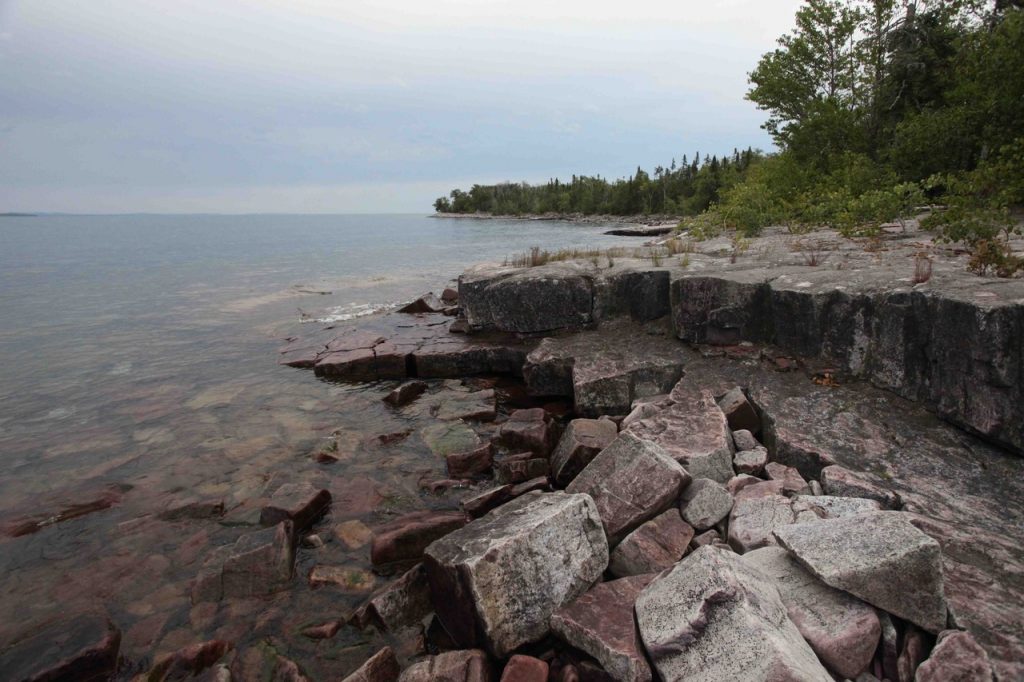Last Winter in the Copper Country – Steppin’ In It
Laughing River - by Greg Brown
“There were cabins on Rabbit Island, one out of boards and the other out of round logs. One was built in 1910 by Charles Tormala, his nephew Arthur, and some others. The other cabin was built around 1880 by a man called Berg, and the Finns knew the Island as "Bergin Saari”.
Captain Harry Berg, father of Russell Berg of Jacobsville, told me that he can barely remember being a little boy sitting on a wooden horse and working with a drawknife when his father lived on Traverse Island. Bill Berg, former sheriff of Keweenaw County, had no recollection of the life on the Island, so he was too small or was born later. In my first year of ice fishing we decided to move to the Island and occupy the old Berg camp because it was more spacious and was in good repair".
“The ice was about a foot thick. When we got to the Island we unloaded and turned the horse around toward the bay, and he went straight to the stable door and and waited for Mother to unharness him. Emil, Dad, Dick, I, Felix Salo and Andrew Herraniemi comprised the gang. LIfe began, but it was a pleasure since every man was capable of doing something.
There was much to do: shovel snow away from the door, get wood, set the net, and a host of other things. Dad set the rabbit snares. Rabbits had chewed the floor planks and the table and window sills, but with the gang at work the camp was made liveable for that night. In fact, it was the first time any of us had spent a night on the Island. There were lot of fisherman on the ice that winter. Mine conditions were not quite back to normal, and many men were idle. Another group of men opened the other cabin and that became filled and seven more had to sleep at a bonfire.”
“In 1930 I bought Rabbit Island. I did some work on it and built a dock on each side of the point. I dwelled in the log cabin, made a trail thru the middle of the island, made a garden and stored the potatoes and other vegetables in a small root cellar for ice fishing time. I’d always had $10 to $15 worth of canned goods in the upper bunk.”
“One day an Indian sailboat was on its way to the blueberry plains. I put the 40 power telescope on them and lo and behold, they went down around my camp. Immediately I got my outboard out and sailed out there, but when I got near the Island they upped their sail and headed toward Keweenaw Point. I went into the camp and saw everything missing. Not having a very large outboard, it took me a couple miles to catch up to them. The old man had a rifle ready when I approached, but I told him I had a gun also. After some arguing I demanded all the things, and they finally surrendered them. It was Shelafoe and his common law wife.”
“I started to rebuild my dock and breakwater [at Rabbit Bay] in the early 30’s. It was a tremendous task. I rented a 30-foot trapnet scow from Henry Tormala to haul rocks from Rabbit Island. I used trucks to haul from Kuusisto’s farm and some smaller boats too; altogether I hauled about a thousand tons of rocks from the Island.”
“Too often there are men so anxious to catch a fish or two that they take the chance. An old timer is never too smart in solving ice conditions, so what chance has a newcomer? An old fisherman may take a chance but always has on hand a boat so he can get across if the ice breaks or is not thick enough or has honeycombed. A man of long experience can recall incidents of the impossible happening, and often he is very cautious. Some have experienced close shaves and have become overcautious or have quite altogether. But Lake superior trout being of such superior quality to all other fish in the world, it is enticing to try to get them one way or the other, by bobbing thru the ice or by trolling from a boat or spearing them thru the ice from a dark shanty. It has fascinated me since I first found out fish can be caught by such simple equipment. The early Finn first learned the art from the Indians.
Fishing always improved toward spring even on the Big Reef. It was common to get 20-30 nice trout. One day Dad, Dick and I were the only ones out there, and we got about a hundred trout.”
“…the [rabbit bay] district was a a veritable wilderness, covered with dense forests–possessed of a wild and somber beauty. This old pioneer and his wife exemplify the sturdy, sterling qualities of the early Finns who came to America.” –Helen Torkkola, 1939
On a sunny, calm day in the summer of 1911, a beautiful cabin cruiser appeared from Portage Entry and proceeded past our place and dropped anchor out from Rabbit Bay River about a thousand feet from shore.
They had a small rowboat in tow, and soon some men and women piled in and headed for shore.
In the afternoon a fresh east wind picked up and continued to increase, and by the time they came off the river the lake was rolling quite well. One man ventured out the the craft but came back to the others. They decided to stay on shore and entered the cabin a quarter mild from the river.
During the night a full-fledged east storm and rain developed. When we awoke the next morning no boat was to be seen at anchor; but upon closer looking one could see it beached about a half mile south of the river. The raging seas were pounding the craft, which was no lengthwise on the sand beach.
Emil and Olli Horsma decided to do something about it, so they constructed a Russian winch at the edge of the woods and cut and peeled a couple of slippery balsam poles and forced one under the bow and another under the stern. They threw a rope around the boat and started to heave on the line with the powerful winch. Little by little the boat was wrested from the water so it was not at the mercy of the waves.

Rabbit Island
